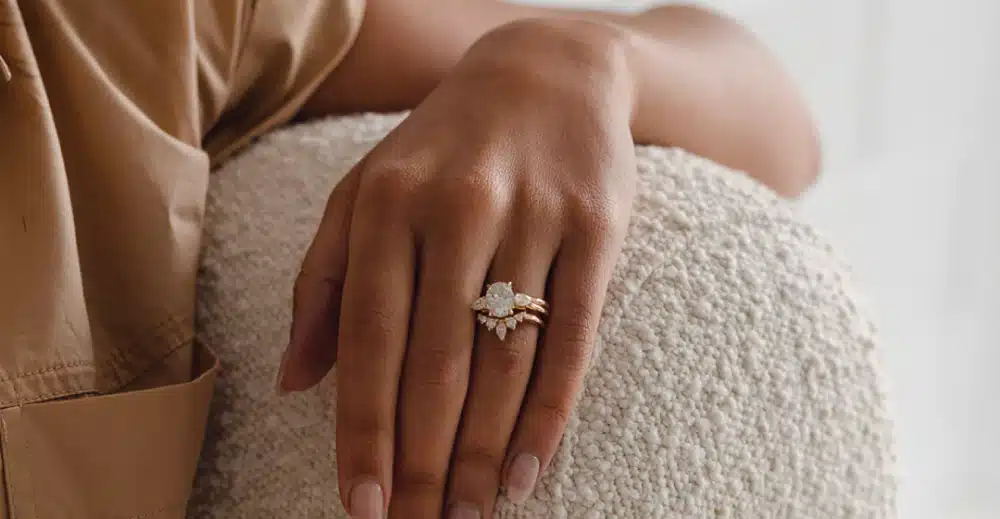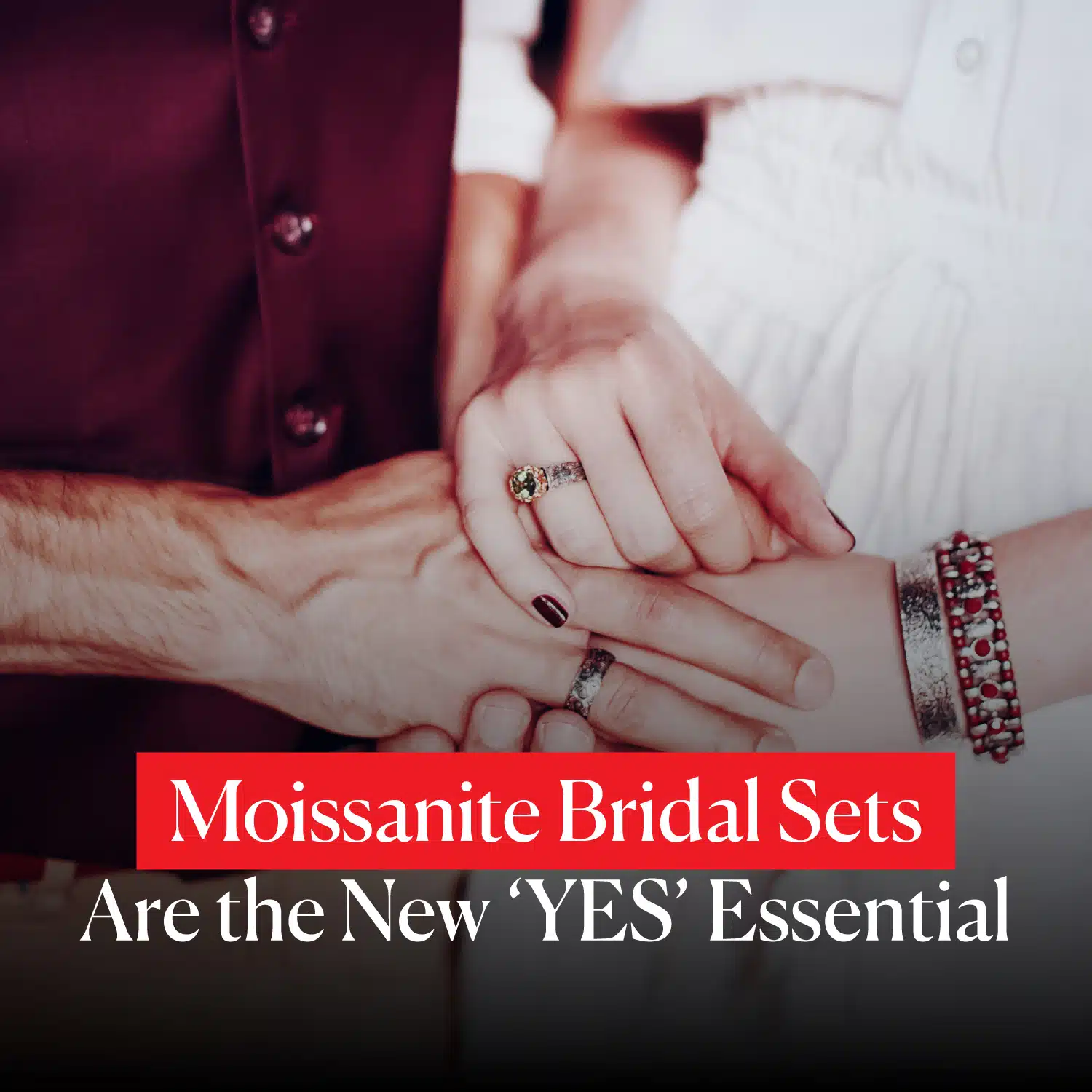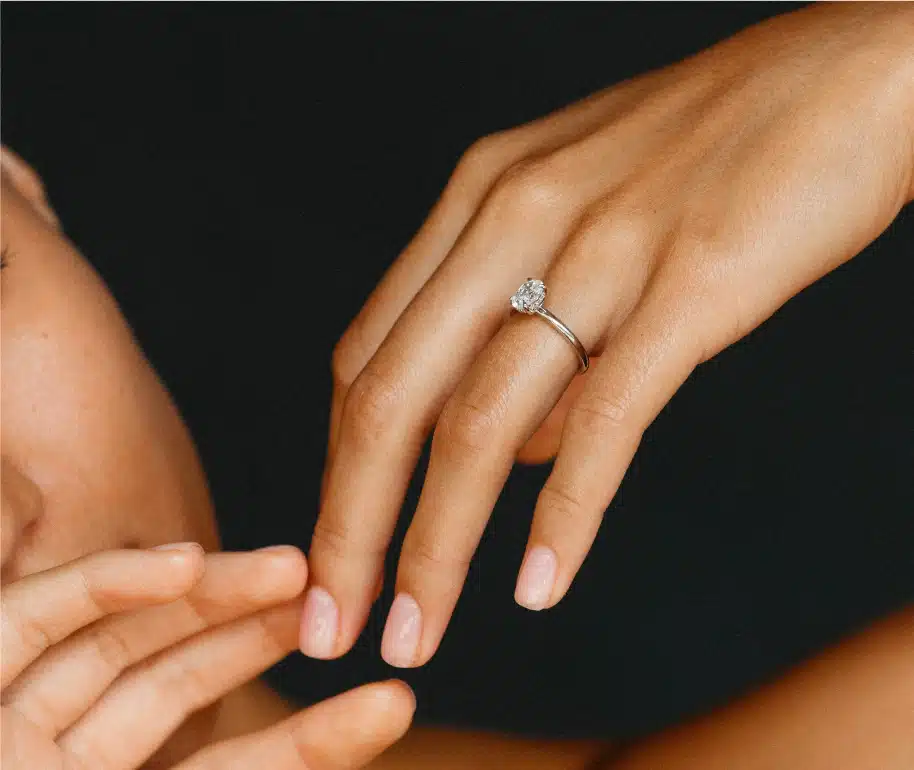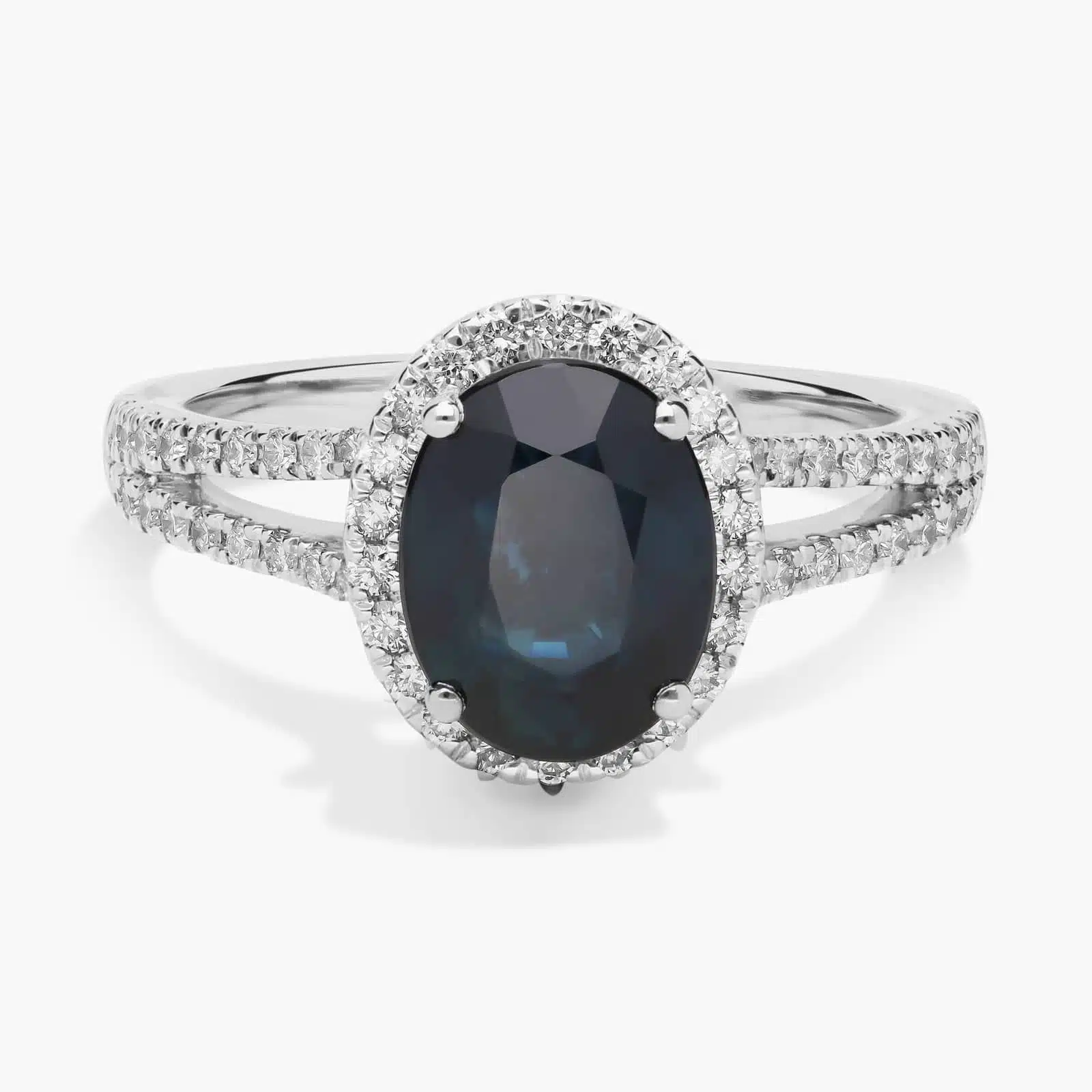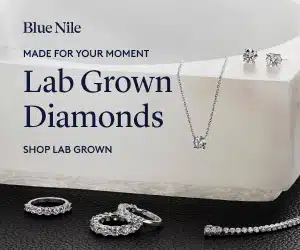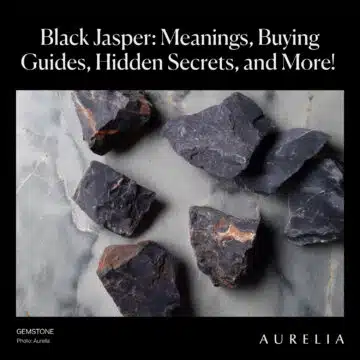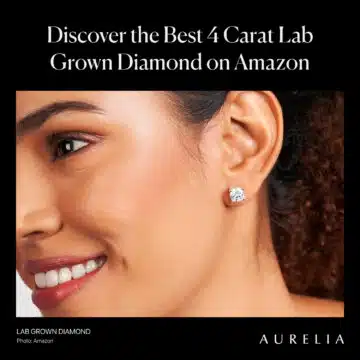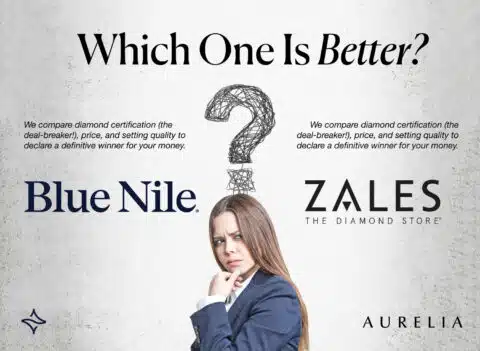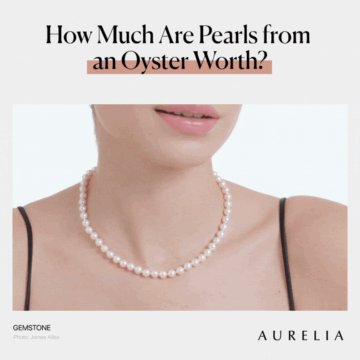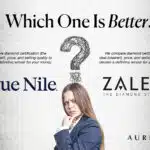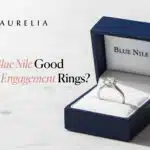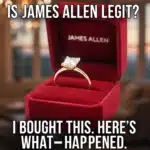What Color Diamond Is the Most Expensive?—icy D, rare red, or something else? Let’s explore every sparkling possibility! When it comes to diamonds, color isn’t just about beauty—it’s a huge part of what makes them expensive.
As one of the Diamond 4Cs (cut, clarity, color, carat), diamond color can send prices soaring, whether it’s the pure, colorless shine of a D-grade gem or the jaw-dropping rarity of a fancy hue like red, blue, or pink.
The most expensive diamond color isn’t a one-size-fits-all answer—it depends on rarity, type, and what buyers crave. A diamond color price can range from thousands to millions, driven by how nature (or a lab) paints these stones.
Here’s what we’re diving into: red diamonds reign as the priciest overall, D color tops the colorless category, and famous stunners like the Hope Diamond show off the high rollers. We’ll compare expensive diamond hues, break down costs, and share buying tips—whether you’re a pro, a dreamer, or just curious. There’s something here for everyone.
Want a head start? Check out our diamond color and clarity chart to see how color fits into the diamond puzzle. Ready to uncover the priciest sparkle? Let’s go!
- How Diamond Color Drives Cost
- D Color: The Most Expensive Colorless Diamond
- Red Diamonds: The Priciest Color Overall
- Blue Diamonds: Luxury Runner-Up
- Other Fancy Contenders: Pink, Green, and More
- Cost Comparison Table: White vs. Fancy
- Natural vs. Lab-Grown: Price Breakdown
- Famous Expensive Diamonds
- Why These Colors Cost a Fortune
- Choosing Your Diamond Color: Price Meets Preference
- FAQ: Diamond Color Cost Answers
- Conclusion
How Diamond Color Drives Cost
Diamond color isn’t just eye candy—it’s the engine behind a gem’s price tag, whether we’re talking diamond color value or fancy diamond price. The Gemological Institute of America (GIA) sets the stage with its D-Z scale for white diamonds: D is pure colorless diamond cost territory—zero tint—while Z lands in light yellow or brown land.
But that’s just the start. Beyond Z, you’ve got fancy colors—think vivid reds, blues, pinks, even greens—where rarity flips the script. Cost comes down to a wild mix of factors: how rare a color is (reds are unicorns, Js are everywhere), how pure it is (D’s no-tint perfection), and how much hype the market throws at it (collectors go nuts for fancy hues).
Here’s the broad breakdown:
- GIA Diamond Color Scale Basics:
- D: Colorless—top-tier rarity, max sparkle.
- G: Near-colorless—still white, way more common.
- J: Faint tint—warmth creeps in, price drops.
- Z: Light yellow/brown—common and cozy.
- Fancy Colors Kick In:
- Red: Ultra-rare crimson—20-30 exist worldwide.
- Blue: Boron-born azure—scarce but more than red.
- Pink: Soft and stunning—rarer than most whites.
- What Drives the Price?:
- Rarity: Fewer reds or Ds mean higher costs.
- Purity: D’s lack of tint jacks up colorless diamond cost.
- Defects: Fancy hues (red, blue) come from crystal quirks—super rare.
- Demand: Jewelers love D; collectors chase red and pink.
- Size: Bigger stones amplify rarity and price—fancy colors especially.
White vs. Fancy Cost Comparison Table
| Color Type | Example Grade | Rarity | Price Range (1-carat) | Key Cost Driver |
|---|---|---|---|---|
| White | D | Very rare | $9,000-$10,000 | Colorless purity |
| White | J | Common | $3,000-$4,500 | Faint tint |
| Fancy | Red | Ultra-rare | $1M+ | Extreme scarcity |
| Fancy | Blue | Rare | $200K-$4M | Unique hue |
Want to dig deeper? Check out D color diamond for the colorless scoop, or explore more in What Is the Best Color for a Diamond? to see how cost and beauty collide.
D Color: The Most Expensive Colorless Diamond
For white diamonds, D color diamonds are the undisputed champs—the most expensive colorless diamond on the GIA’s D-Z scale. Picture this: no tint, no yellow, no brown—just a crystal-clear gem that catches light like a prism on steroids.
It’s the D diamond value pros drool over: rarest of the colorless crew, delivering flawless brilliance that’s tough to beat. Whether you’re a jeweler crafting a masterpiece or a buyer wanting top resale, D’s the go-to.
It’s not just pretty—it’s a status symbol, a benchmark of perfection that’s been billions of years in the making.
Why D Rules the White Diamond World
- Rarity: Only a tiny slice of mined diamonds hit D—nature’s pickiest work.
- Brilliance: Zero tint means max light return—sparkle city.
- Versatility: Glows in platinum, white gold, even rose gold—any setting sings.
- Resale Power: Holds colorless gem cost better than lower grades.
- Downside: Price—$9,000-$10,000+ for a 1-carat natural ain’t cheap.
A 1-carat D, VS1 clarity, excellent cut from D color diamonds at James Allen at $9,500 glows icy white in a platinum band—pure luxury you can feel. Compare that to a lab-grown D from D color diamonds at Blue Nile at $4,000—same shine, half the hit. D’s the priciest white diamond because it’s the pinnacle of what colorless can be.
Best Deal Of The Year – Final Days
Blue Nile’s “Clear The Vault” is ON.
Shop Fine Jewelry Upto 70% OFF.
*Exclusions may apply. See Blue Nile for complete details.
D vs. Other White Grades Table
| Grade | Look | Cost (1-carat) | Rarity | Vibe |
|---|---|---|---|---|
| D | Pure colorless | $9,000-$10,000 | Very rare | Icy luxury |
| E | Almost colorless | $7,500-$9,000 | Rare | Subtle elegance |
| G | Near-colorless | $4,500-$6,000 | Moderate | Bright value |
| J | Faint tint | $3,000-$4,500 | Common | Warm charm |
Red Diamonds: The Priciest Color Overall
Say hello to the undisputed heavyweight champ of diamond colors—red diamonds. These fiery beauties claim the title of most expensive diamond color in the world, and it’s not even close. With only 20-30 known to exist globally, their rare red diamond status makes them a collector’s holy grail.
A red diamond price starts at $1 million per carat and skyrockets from there, leaving even the priciest white diamonds in the dust.
What makes them so special? It’s a perfect storm of rarity and nature’s magic: crystal lattice defects bend light into a pure, vivid red hue—a one-in-a-billion fluke that’s almost never seen in the wild. These aren’t just gems; they’re history, art, and investment rolled into one.
Why Red Diamonds Cost a Fortune
- Unmatched Scarcity: 20-30 reds exist worldwide—some mines go decades without finding one.
- Unique Hue: No impurities here—just structural magic creating a fancy color cost that’s pure crimson.
- Collector Frenzy: Auction houses buzz when a red hits the block—bidders go wild.
- Size Impact: Even tiny reds (under 1 carat) fetch millions; larger ones shatter records.
- Catch: You can’t stroll into a store for one—most are auction-only or custom-sourced.
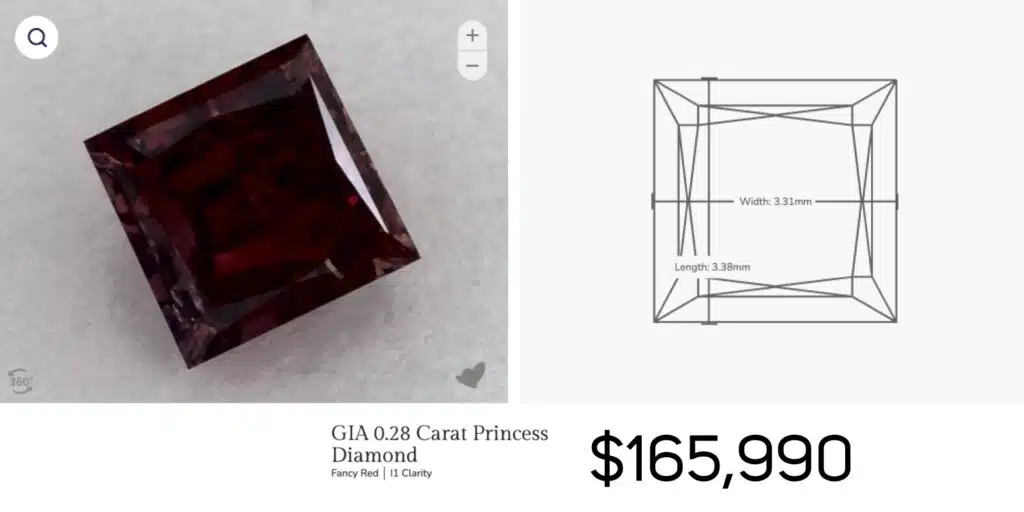
Take the famous 5.11-carat Moussaieff Red—it sold for $8 million, a jaw-dropping $1.5 million per carat! But you don’t need millions to dream. Check out this stunner: a 0.28-carat Fancy Red, I1 clarity, princess-cut diamond from James Allen at $165,990.
With a good polish and symmetry, a 73.0 table, and a 70.4 depth, this gem measures 3.38 x 3.31 x 2.33 mm (L/W ratio of 1.02)—a compact beauty with a very thick to extremely thick girdle and no fluorescence.
DIAMOND ON SALE!!
⏰ Tick-Tock! The Best Diamond Deals at James Allen Are Disappearing Fast!
It’s a fancy color cost that’s more accessible than auction pieces but still packs that rare red punch. Compare that to a 1-carat D color at $9,500—red’s per-carat price makes D look like a bargain.
For a more budget-friendly tinted option, see our J color diamond guide—way more common and affordable. Red’s the priciest color overall because it’s a once-in-a-lifetime find.
Red vs. D vs. J Comparison Table
| Color | Rarity | Cost (per carat) | Look | Availability | Notable Features |
|---|---|---|---|---|---|
| Red | Ultra-rare | $1M+ (0.28ct: $165,990) | Vivid crimson | Almost none | Fancy Red, I1, 3.38×3.31mm, 70.4 depth |
| D | Very rare | $9,000-$10,000 | Pure colorless | Limited but more | Colorless, high resale value |
| J | Common | $3,000-$4,500 | Faint tint | Widely available | Warm yellow, budget-friendly |
Blue Diamonds: Luxury Runner-Up
Blue diamonds are the dazzling runners-up in the world of high-end gems, captivating with their rare diamond hue born from traces of boron in their crystal structure. They’re not as scarce as reds, but they’re still elite—only a fraction of diamonds mined carry this azure magic, making them a luxury pick.
The blue diamond price reflects their rarity, ranging from $200,000 to $4 million per carat for vivid shades, depending on intensity, size, and clarity.
That fancy blue cost positions them as a collector’s dream, often outpricing white diamonds in total value for larger stones, though they can’t match red’s per-carat rarity.
Why Blue Diamonds Are a Luxury Pick
- Boron’s Touch: Tiny boron atoms create that stunning blue—nature’s rare recipe.
- Rarity Level: Less rare than reds (20-30 exist), but still one in 10,000 diamonds is colored.
- Shade Spectrum: From light blue to fancy deep blue—deeper hues command higher prices.
- Mining Origins: Mostly from South Africa’s Cullinan mine, with some from India and Australia.
- Investment Value: Blues hold strong resale—think heirloom or museum piece.
- Catch: High clarity (IF) blues cost more; inclusions (SI2) can lower the price.
The 45.52-carat Hope Diamond, a Fancy Deep Blue, is valued at $250 million—not for sale, but a shining example of blue’s allure. For something you can actually own, Blue Nile has some breathtaking options.
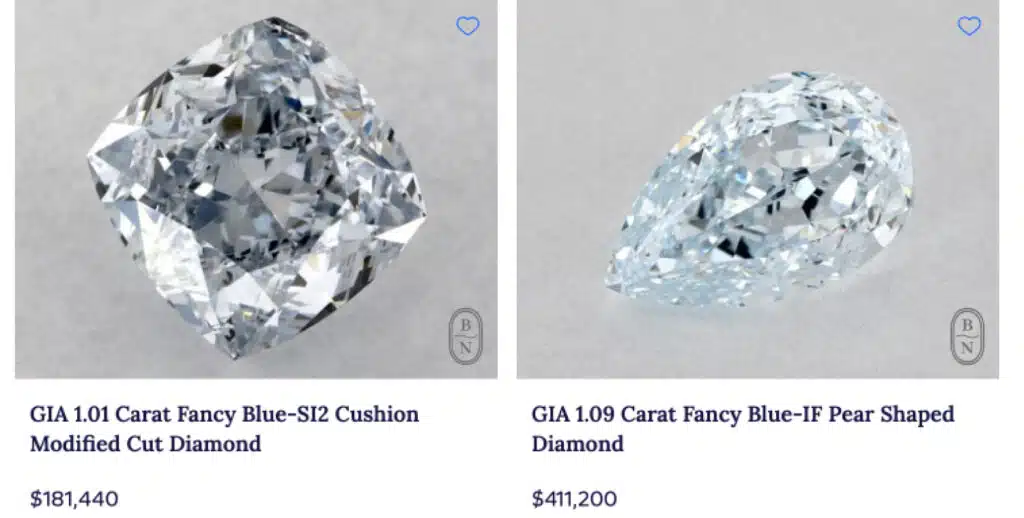
Take this 1.01-carat Fancy Blue, SI2 clarity, cushion modified cut diamond, priced at $181,440 Blue Nile. It’s a rich blue with a balanced cut, perfect for a bold pendant. Or consider a 1.09-carat Fancy Blue, IF clarity, pear-shaped diamond at $411,200 Blue Nile—its internally flawless clarity and elegant shape make it a premium pick.
Read Our 5-Star Blue Nile Review
Check our comprehensive Blue Nile review to learn why we rated Blue Nile 5 stars for their exceptional quality and value.
Compare to a 1-carat D color at $9,500—larger blues like the Hope outprice D in total value, but red’s rarity keeps it on top. For a near-colorless contrast, check out our F color diamond guide. Browse more at Blue diamonds at James Allen.
Blue vs. D Comparison Table
| Color | Rarity | Cost (per carat) | Look | Notable Features |
|---|---|---|---|---|
| Blue | Rare | $180K-$376K | Rich blue | 1.01ct, SI2, $181,440 (Blue Nile) |
| Blue | Rare | $180K-$376K | Deep blue | 1.09ct, IF, $411,200 (Blue Nile) |
| D | Very rare | $9,000-$10,000 | Pure colorless | Colorless, high brilliance |
Other Fancy Contenders: Pink, Green, and More
The expensive fancy colors don’t stop at red and blue—pinks, greens, yellows, and even purples join the party, each with a rare diamond color tale to tell. Pinks can fetch $100,000 to $2 million per carat, depending on their intensity, while greens range from $50,000 to $500,000 per carat for vivid shades.
Yellows, more common, still hit $10,000-$50,000 per carat for deep canary hues, and purples—ultra-rare—can rival pinks in cost. These costly gem hues owe their price to unique formation processes and the collector demand that sends auction prices into the stratosphere.
What Makes These Fancy Colors Special
- Pink Perfection: Crystal deformation during formation creates soft pinks—rarer than most whites.
- Green Radiance: Natural radiation exposure tints them—think emerald or lime shades.
- Yellow Brilliance: Nitrogen gives a sunny glow, from faint to vivid canary.
- Purple Rarity: Often mixed with pink or blue, purples are a collector’s unicorn.
- Auction Fever: Pink diamond price and others soar with investor hype.
- Geological Magic: Each hue’s a billion-year fluke—nature’s art at its finest.
The 59.6-carat Pink Star, a Fancy Vivid Pink, sold for $71.2 million—that’s $1.2 million per carat! A 5.03-carat Fancy Vivid Green once fetched $3 million—about $600,000 per carat. A 12.03-carat Fancy Vivid Yellow, the “Martian Yellow,” sold for $1.3 million—around $108,000 per carat.
Compare to a 1-carat D at $9,500—fancy colors like pink often beat D’s total price for big stones, especially at auction. For a near-colorless option, see our G color diamond guide—same sparkle, fraction of the cost.
Fancy Colors Price Table
| Color | Rarity | Cost (per carat) | Look | Why Expensive |
|---|---|---|---|---|
| Pink | Very rare | $100K-$2M | Soft pink | Crystal deformation, high demand |
| Green | Rare | $50K-$500K | Forest green | Radiation tint, collector appeal |
| Yellow | Moderate | $10K-$50K | Canary yellow | Nitrogen, more common |
| Purple | Ultra-rare | $100K-$1M+ | Deep purple | Extreme rarity, mixed hues |
Cost Comparison Table: White vs. Fancy
Let’s lay out the diamond color cost comparison across white and fancy diamonds, from the priciest reds to budget-friendly Js. This table dives into expensive diamond grades, price of diamond hues, and availability, helping you find the best diamond color price—whether you’re after luxury, rarity, or value.
| Color | Rarity | Cost (per carat) | Look | Availability | Notable Example |
|---|---|---|---|---|---|
| D | Very rare | $9,000-$10,000 | Pure colorless | Limited but more | 1-carat, VS1, $9,500 |
| Red | Ultra-rare | $1M+ | Vivid crimson | Almost none | 0.28-carat, $165,990 (James Allen) |
| Blue | Rare | $180K-$376K | Deep blue | Very limited | 1.09-carat, IF, $411,200 (Blue Nile) |
| Pink | Very rare | $100K-$2M | Soft pink | Limited | 59.6-carat Pink Star, $1.2M/carat |
| G | Moderate | $4,500-$6,000 | Near-colorless | Common | 1-carat, VS2, $5,200 (James Allen) |
| J | Common | $3,000-$4,500 | Faint tint | Widely available | 1-carat, VS2, $3,800 |
A 1-carat G, VS2 from G color diamonds at James Allen at $5,200 contrasts a $1M red speck—value versus rarity in action! For more white diamond options, explore our E color diamond and H color diamond guides.
James Allen: Our 5-Star Choice for Price and Selection
Check our comprehensive James Allen Review to learn more about their pricing and commitment.
Natural vs. Lab-Grown: Price Breakdown
When it comes to diamond color rarity, the battle between natural and lab-grown diamonds changes the price game entirely. Natural diamonds carry the weight of billions of years underground, making their natural diamond color cost sky-high—especially for rare colors.
Lab-grown diamonds, crafted in controlled environments, deliver the same sparkle at a fraction of the lab grown diamond price. Whether you’re eyeing a colorless D, a fiery red, or a deep blue, the expensive lab diamonds trend makes luxury more accessible—but with trade-offs. Let’s break down how natural and lab-grown prices stack up across these coveted hues.
Diamond IQ Test: Natural or Lab-Grown?
Two identical diamonds: GIA Certified, 1.51ct, D Color, VVS1, Ideal Cut. One is natural ($16,530), the other is lab-grown ($2,390). Choose the diamond you like better and see if you can match it to its origin.
Natural vs. Lab-Grown: The Cost Gap
- Natural Diamonds:
- D Color: $9,000+ for 1-carat—rare and pure.
- Red: $1M+ per carat—only 20-30 exist globally.
- Blue: $200K-$4M per carat—vivid shades are scarce.
- Lab-Grown Diamonds:
- D Color: $4,000 for 1-carat—same look, less rarity.
- Red: Thousands, not millions—synthetic reds are more common.
- Blue: Thousands to low millions—lab blues are easier to make.
- Why the Difference?:
- Natural: Geological rarity, mining costs, market prestige.
- Lab: Faster production (weeks, not eons), lower overhead, less scarcity.
- Resale Reality: Naturals hold value better; labs often don’t.
A lab-grown D, VS1 clarity, excellent cut from Ritani at $4,000 saves thousands compared to a natural D at $9,500—same icy sparkle, half the price. Lab-grown reds and blues follow suit: a 1-carat lab blue might cost $10,000-$50,000, while a natural blue hits $200,000+. Want more lab-grown options? Check out Vrai for stunning synthetic colors at a steal.
Natural vs. Lab-Grown Price Table
| Color | Type | Cost (per carat) | Pros | Cons |
|---|---|---|---|---|
| D | Natural | $9,000-$10,000 | High resale, prestige | Expensive, rare |
| D | Lab-Grown | $4,000 | Affordable, same look | Lower resale value |
| Red | Natural | $1M+ | Ultra-rare, collector gem | Unaffordable, scarce |
| Red | Lab-Grown | $5K-$50K | Accessible, still stunning | Less unique, common |
| Blue | Natural | $200K-$4M | Rare, investment-worthy | Pricey, hard to find |
| Blue | Lab-Grown | $10K-$100K | Budget-friendly, vivid hue | Lower prestige, less rare |
Famous Expensive Diamonds
Some diamonds aren’t just pricey—they’re legends, setting records and stealing headlines with their iconic diamond colors. These priciest diamond names showcase the most expensive diamond ever contenders, from deep blues to vivid pinks, each with a story of rarity and jaw-dropping famous gem costs. Let’s spotlight three that define luxury and prove why color can cost a fortune.
Iconic Diamonds and Their Costs
Let’s shine a spotlight on three legendary diamonds that have made history with their iconic diamond colors and staggering famous gem costs.
1. Hope Diamond

First up is the Hope Diamond, a Fancy Deep Blue masterpiece weighing 45.52 carats, valued at an estimated $250 million—though it’s not for sale. Its price tag comes from being one of the largest deep blues ever found, with a haunting history of curses and its current home at the Smithsonian.
The Boron in its structure gives that mesmerizing blue hue, a rare diamond color that’s as captivating as its lore.
Hope Diamond (Blue) Overview:
- Color: Fancy Deep Blue
- Size: 45.52 carats
- Value: $250 million (estimated, not for sale)
- Why Costly: One of the largest deep blues, with a cursed history and museum status at the Smithsonian. Boron gives its iconic hue—rare and mesmerizing.
2. Moussaieff Red
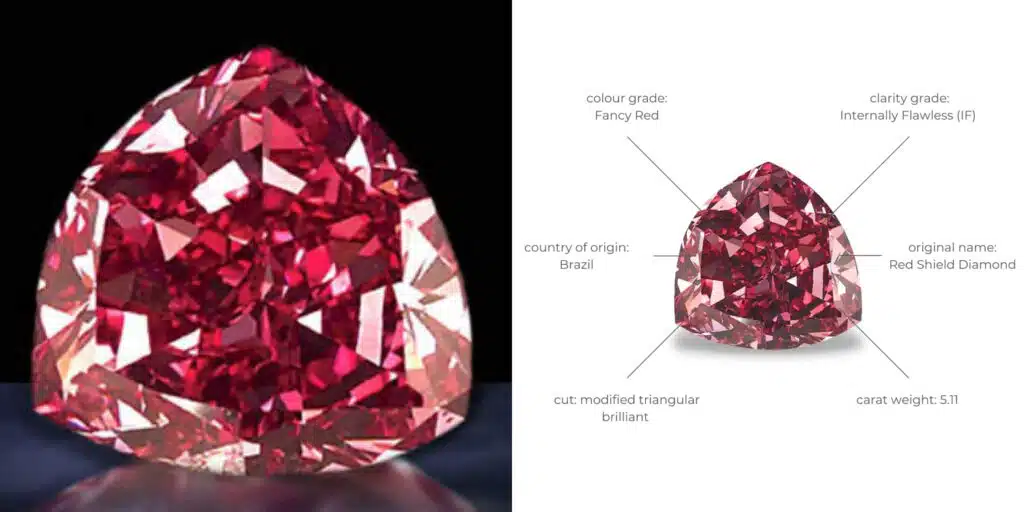
Next, the Moussaieff Red, a 5.11-carat Fancy Red, sold for $8 million—that’s $1.5 million per carat. It’s one of the largest reds ever discovered, a true unicorn with only 20-30 reds known to exist.
Its pure crimson shade and unique triangular cut make it a collector’s dream, cementing its status as a priciest diamond name in the fancy color world.
Moussaieff Red (Red) Overview:
- Color: Fancy Red
- Size: 5.11 carats
- Sale Price: $8 million ($1.5M per carat)
- Why Costly: One of the largest reds ever—only 20-30 exist. Its pure crimson hue and triangular cut make it a collector’s dream.
3. Pink Star

Finally, the Pink Star, a 59.6-carat Fancy Vivid Pink, fetched $71.2 million at auction—$1.2 million per carat. It’s the largest vivid pink ever graded by the GIA, with a flawless oval cut that highlights its soft, glowing hue.
The rarity of pink diamonds, combined with its massive size, drove this record-breaking sale, making it a most expensive diamond ever contender in the pink category.
Pink Star (Pink) Overview:
- Color: Fancy Vivid Pink
- Size: 59.6 carats
- Sale Price: $71.2 million ($1.2M per carat)
- Why Costly: Largest vivid pink ever graded, with a flawless oval cut. Pink’s rarity and size drove its record-breaking auction price.
These gems are leagues above a 1-carat D at $9,500, showing how fancy colors dominate for big stones. Want a budget contrast? A 1-carat I color diamond at $4,500 offers sparkle without the million-dollar tag.
| Diamond | Color | Size | Value/Sale Price | Why It’s Pricy |
|---|---|---|---|---|
| Hope Diamond | Fancy Deep Blue | 45.52ct | $250M (est.) | Huge size, deep blue, history |
| Moussaieff Red | Fancy Red | 5.11ct | $8M ($1.5M/ct) | Ultra-rare red, large for color |
| Pink Star | Fancy Vivid Pink | 59.6ct | $71.2M ($1.2M/ct) | Largest vivid pink, flawless cut |
Why These Colors Cost a Fortune
Ever wonder why diamond color costs so much? It’s not just about looking pretty—expensive diamond rarity and costly diamond hue prices come down to nature, scarcity, and human obsession. Whether it’s a colorless D, a fiery red, or a deep blue, the diamond value factors behind their price tags are a mix of geological odds and market madness. Let’s break it down.
What Drives Diamond Color Costs
- Geological Odds:
- Red’s Defects: Reds form from rare crystal lattice twists—less than 30 exist after billions of years.
- Blue’s Boron: Trace boron creates blues—one in 10,000 diamonds gets this lucky.
- Pink’s Pressure: Extreme pressure deforms crystals into pinks—rarer than most whites.
- Mining Scarcity:
- D’s Rarity: Only a tiny fraction of mined diamonds are colorless D-grade—most have some tint.
- Fancy Colors: Reds and blues are needles in a haystack—mines might see one per decade.
- Demand Dynamics:
- Collectors vs. Jewelers: Collectors chase reds and blues for rarity; jewelers love D for its universal appeal.
- Auction Hype: Fancy colors like pink break records—investors see them as art.
- Size and Quality:
- Bigger Stones: Larger fancy colors (5+ carats) multiply in value—think Pink Star.
- Clarity Boost: High clarity (IF) in blues or reds pushes prices higher.
A 1-carat E color diamond at $8,000 reflects rarity just below D—still a splurge, but more accessible. Want to see how clarity plays in? Check our diamond color and clarity chart for the full picture.
| Color | Rarity Factor | Cost Impact | Demand Driver |
|---|---|---|---|
| Red | Crystal defects | $1M+ per carat | Collector obsession |
| Blue | Boron presence | $200K-$4M per carat | Museum/investor hype |
| D | No-tint purity | $9,000-$10,000 | Jeweler favorite |
Choosing Your Diamond Color: Price Meets Preference
Picking a diamond color is where choosing expensive diamond color meets your personal style and wallet—it’s all about balancing diamond color budget with what makes your heart race. Do you want the most valuable diamond hue for investment, or a stunning gem to wear every day?
Let’s break it down with some diamond price tips to help you decide, whether you’re splurging on luxury or hunting for value.
Tips to Find Your Perfect Diamond Color
- Budget:
- Splurge: A 1-carat D color at $9,000+ is the priciest white—pure, colorless perfection.
- Save: A 1-carat J color at $3,000-$4,500 brings warmth for a fraction of the cost.
- Middle Ground: G color at $5,200 offers near-colorless sparkle without the D price tag.
- Style:
- Colorless (D-G): Icy white, like D or G color diamond—perfect for a crisp, modern look.
- Warm (J-K): Cozy yellow tint, like J or K—great in gold settings for a vintage vibe.
- Fancy (Red/Blue): Bold and rare, like red or blue—think statement pieces or collector gems.
- Use:
- Investment: Reds or blues hold value—red at $1M+ per carat is a collector’s dream.
- Everyday Wear: D or G offers timeless sparkle for daily dazzle.
- Unique Flair: Fancy colors like pink or yellow add personality to special pieces.
- Setting Matters:
- Platinum/White Gold: Highlights D-G’s crispness.
- Yellow/Rose Gold: Flatters J-K’s warmth, making the tint look intentional.
- Clarity Pairing: Higher clarity (VS2+) in colorless stones shows off purity; lower clarity (SI1) in tinted stones hides flaws better.
A 1-carat K, VS2 clarity, excellent cut from K color diamond at $3,200 dazzles in yellow gold—its warm tint blends beautifully, and it’s way under D’s $9,000 price! Want even more savings? A 1-carat L color diamond at $2,500-$3,000 offers a similar vibe for less.
Style and Price Table
| Goal | Color Pick | Price (1-carat) | Look | Best For |
|---|---|---|---|---|
| Max luxury | D | $9,000+ | Pure colorless | Timeless wear |
| Warm & affordable | K | $3,200 | Warm tint | Gold settings |
| Collector’s gem | Red/Blue | $200K-$1M+ | Vivid fancy | Investment |
FAQ: Diamond Color Cost Answers
From red’s rarity to D’s dazzle, here’s what you need to know about expensive diamond hue answers! This diamond color price FAQ tackles the costly diamond color guide questions you’re asking—whether you’re curious about record-breaking gems, white diamond pricing, fancy color comparisons, lab-grown savings, or budget-friendly looks.
Let’s dive into the details with a broad scope for all readers.
Conclusion
Let’s wrap up the diamond color expense summary: red diamonds reign as the priciest diamond color at $1 million+ per carat, thanks to their insane rarity—only 20-30 exist! Among white diamonds, D color tops the list at $9,000+, the pinnacle of colorless beauty.
Blues and pinks follow in the fancy color race, with most costly diamond shade prices from $100,000 to $4 million per carat, driven by their vivid hues and collector appeal.
You don’t need millions to shine, though—a 1-carat J from J color diamonds at Blue Nile at $3,800 keeps it stunning and sane, blending warmth with affordability.
Luxe or budget, there’s a diamond color for you. Want to explore more? Dive into options at Ritani and find your perfect sparkle—whether it’s a fiery red, an icy D, or a budget-friendly J. What’s your dream hue?

